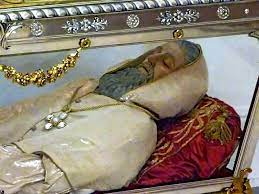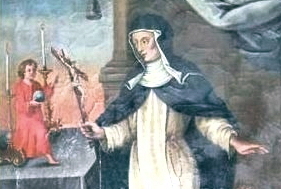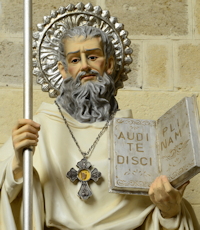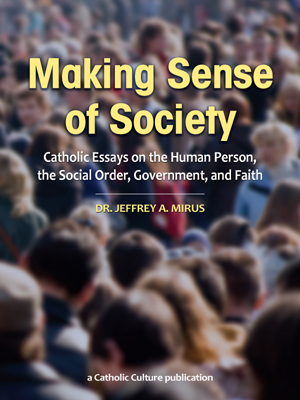Ordinary Time: June 20th
Tuesday of the Eleventh Week in Ordinary Time
Other Commemorations: St. John Matera, Abbot (RM); Bl. Margareta Ebner, Virgin (RM) ; Other Titles: John Pulsano
» Enjoy our Liturgical Seasons series of e-books!
The Roman Martyrology commemorates on this date St. John Matera (also John Pulsano) (1070-1139). St. John was a native of Matera, Italy and in his childhood longed to become a hermit. As a young man, he worked for a time as a shepherd in the service of a monastery. His exceptional austerity, however, was so irksome to the less fervent monks that he soon had to leave. Thereafter he journeyed from place to place as he strove to carry out God's will for him. At one point, acting upon a vision of Saint Peter he had experienced, John rebuilt a dilapidated church dedicated to the saint. Later, he traveled to Bari, where he preached with great efficacy. Certain individuals, motivated perhaps by jealousy, attacked the popular preacher with false charges of heresy, but he was in the end totally cleared of their accusations. Eventually John founded a Benedictine monastery at Pulsano and became its first abbot.
Blessed Margareta Ebner (1291-1351) is also commemorated today. She was a Dominican nun at the Maria Medingen monastery near Dillingen, is one of the most important representatives of 14th century German female mysticism. She fell seriously ill in 1312 and was sick and bedridden all her life. She formed a deep spiritual friendship with the mystic Heinrich von Nördlingen (ca. 1310-1387), whom she met in 1332, with the long correspondence between them constituting the first preserved German-language collection of letters.
St. John of Matera
St. John was born toward the end of the 11th century at Matera, a town in the Kingdom of Naples. On reaching adulthood, he joined a monastery on the island of Taranto. His single-mindedness in keeping the Rule created problems for the others monks and led John to leave. Seeking a monastery that would fit his makeup, the Saint went to Calabria and then to Sicily. In his quest he returned to the mainland at Ginosa. He rebuilt a church nearby dedicated to St. Peter.
 However, John was arrested and imprisoned because there was a belief that he had found and kept hidden treasure. He escaped to Capua and joined the community of St. William of Vercelli. When fire destroyed their dwelling, he journeyed to Bari, where the people were deeply moved by his preaching. A charge of heresy was leveled at the Saint out of jealousy, but he was easily cleared of it. Returning to Ginosa, he was welcomed by his former disciples and preached a successful mission at St. Peter’s Church.
However, John was arrested and imprisoned because there was a belief that he had found and kept hidden treasure. He escaped to Capua and joined the community of St. William of Vercelli. When fire destroyed their dwelling, he journeyed to Bari, where the people were deeply moved by his preaching. A charge of heresy was leveled at the Saint out of jealousy, but he was easily cleared of it. Returning to Ginosa, he was welcomed by his former disciples and preached a successful mission at St. Peter’s Church.
Still following his religious impulse, John went to Mount Gargano and at nearby Pulsano built a monastery. Some sixty monks flocked to his community, and he shepherded them as their Abbot. So well did he do so that he became renowned for his wisdom, miracles, and gift of prophecy. He died on June 20, 1139.
—Excerpted from the Divine Redeemer Sisters
Highlights and Things to Do:
- Read more about St. John:
- He was originally buried in Abbazia di Santa Maria di Pulsano (Saint Mary of Pulsano Abbey) at Pulsano, Italy, but his relics were relocated to the Matera Cathedral.
Bl. Margareta Ebner
 Margareta Ebner was a Nun of the Order of Preachers. Bl. Margaret was born in 1291 at Donauworth in Bavaria and made her profession in the Dominican monastery at Maria Medingen in 1306. By her own account, her true conversion to God began in 1311, when she was twenty years old. Shortly thereafter she fell seriously ill and remained bedridden for nearly thirteen years. This life of continual suffering and prayer brought her to the heights of contemplative union with God. She became one of the most prominent of the Rhineland mystics, known and admired by her Dominican brothers, John Tauler and Henry Suso.
Margareta Ebner was a Nun of the Order of Preachers. Bl. Margaret was born in 1291 at Donauworth in Bavaria and made her profession in the Dominican monastery at Maria Medingen in 1306. By her own account, her true conversion to God began in 1311, when she was twenty years old. Shortly thereafter she fell seriously ill and remained bedridden for nearly thirteen years. This life of continual suffering and prayer brought her to the heights of contemplative union with God. She became one of the most prominent of the Rhineland mystics, known and admired by her Dominican brothers, John Tauler and Henry Suso.
Margaret's spirituality as almost entirely Christocentric and was profoundly influenced by the cycle of the liturgical year. One of her favorite invocations (which shows also her sense of Dominican identity) was: "Jesus, pure Truth, teach me the truth." Among her writings are her Spiritual Journal or autobiography, and also a treatise on the Lord's Prayer. She died on June 20, 1351, and she was beatified by Pope John Paul II on February 24, 1979.
Recent years have seen a real surge of interest and publications on Bl. Margaret Ebner and the Rhineland mystics, the most notable being Margaret Ebner: Major Works, edited by Leonard Hindsley (Paulist Press, 1993). Several interesting articles on Margaret and her fellow Rhineland mystics can be found on-line, including "Life in Abundance: Meister Eckhart and the German Dominican Mystics of the the Century: The Importance of Dominican Sisters in German Mysticism" by Gundolf M. Gieraths, O.P. (Spirituality Today, 1986) and "Dominican Spirituality in the Rhineland."
—Excerpted from the Dominican Monastery of Our Lady of the Rosary
Highlights and Things to Do:
- See this digitized copy of her original manuscript in German.
- Read more about Bl. Margaret:
- Say this prayer on Bl. Margareta's feast.
- Pray this beautiful prayer written by Bl. Margareta.








